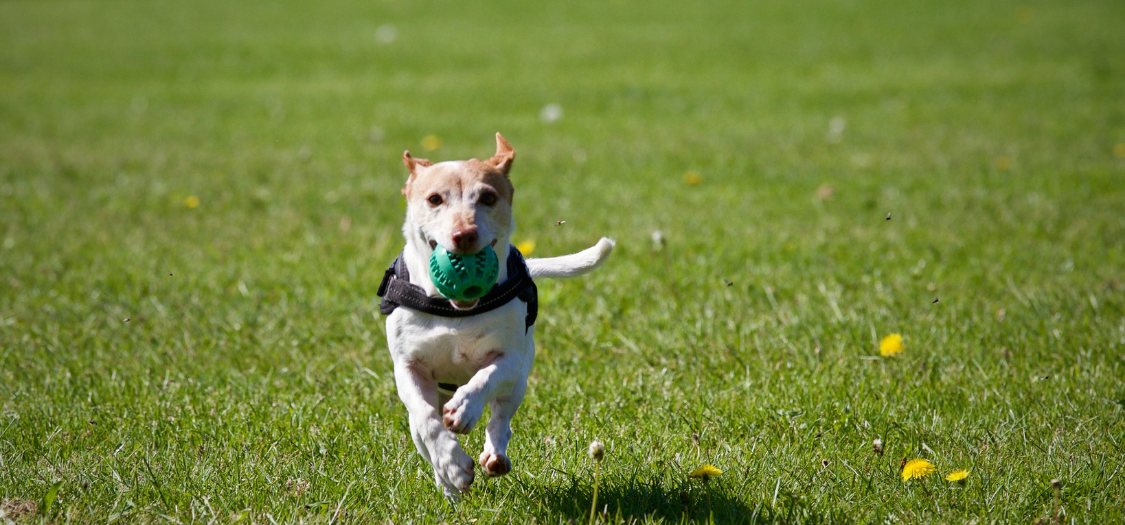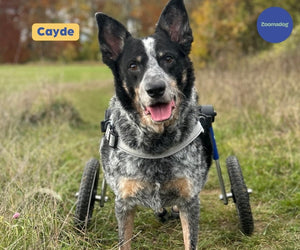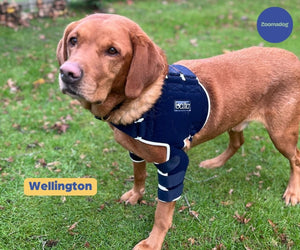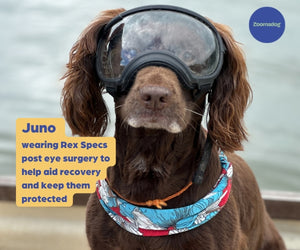01730 622544

Slipped Discs in Dogs - The Complete Guide
What Happens When Your Dog Has Slipped Disc?
When a disc ‘slips’, it means that the disc contents, the nucleus pulposus, is “herniating” i.e. pushing up / protruding through an opening in the annulus fibrosus, into the spinal cord. This puts pressure on the spinal cord, and the nerves which it contains.
The spinal cord doesn’t have anywhere to go because of being held in place by the vertebrae, which are rigid and inflexible. So when the disc pushes onto the spinal cord, it has nowhere to move. This is what results in the pressure on the spinal cord, ending up with it being pinched between the vertebrae’s internal surface and the disc contents. As the spinal cord is effectively a bundle of nerves, anything pressing on to it will cause pain, inflammation, and other possible neurological consequences, such as disruption of the messages between brain and body, or even paralysis. Pressure from the disc material onto the spinal cord has a compression component to the injury. Inflammation and bruising caused by the impact of the disc material onto the spinal cord has a concussion component to the injury.
As the spinal cord is effectively a bundle of nerves, anything pressing on to it will cause pain, inflammation, and other possible neurological consequences, such as disruption of the messages between brain and body, or even paralysis. Pressure from the disc material onto the spinal cord has a compression component to the injury. Inflammation and bruising caused by the impact of the disc material onto the spinal cord has a concussion component to the injury.
A slipped disc is actually a ‘catch all’ non-technical term. You’ll be more likely to hear your vet use the terms “herniated disc”, “disc herniation”, “disc protrusion”, “bulging disc”, or refer to dog “IVDD” (intervertebral disc disease), which is one of the most usual causes of disc herniation.
What Causes a Slipped Disc in Dogs?
There are several reasons why slipped discs happen in dogs:
- Sudden trauma - anything that causes a tear in the annulus fibrosus in an otherwise healthy intervertebral disc. This can be a shock like a dog being hit by a car or being in a car accident, falling from a great height, or twisting/wrenching the spine beyond its limits during play. When a trauma like this happens, the outer layer of the disc breaks or ruptures, allowing the contents of the disc to leak out and then press onto the spinal cord.
- Intervertebral Disc Disease in Dogs (IVDD) - this is a very common cause of slipped discs in dogs. The nucleus pulposus degenerates, dries out, and hardens over time, without any symptoms. Eventually it will push through the annulus fibrosus and poke up into the spinal cord. There are two ways IVDD can manifest:
- Hansen Type I: It can seem like it happens all of a sudden and as if it’s been caused by a small, inconsequential, everyday action such as jumping off the sofa. However, the reality is that the disc’s been degenerating over time. The small action that triggers the slipped disc is just a catalyst, and causes the annulus fibrosus finally to give way and the nucleus pulposus to push out forcefully. The sudden disc protrusion causes bruising and inflammation of the spinal cord. Dogs who have a Hansen Type I slipped disc will generally experience sudden, sharp pain. The degree of damage and consequent disability varies.
- Hansen Type II: This is a slower process and more gradual. The degenerating, thickening nucleus pulposus progressively starts pushing up against the spinal cord. Symptoms can start off subtly and take place over months or years - you’ll see signs such as a reluctance to get up from the floor, play, exercise, go up and down stairs, or they look as if they have a hunched back or are stiff. But there won’t necessarily be one sudden catalyst incident, as in Hansen Type I. Medium to large dogs between 5 and 12 years are more widely represented as suffering from Hansen Type II than other groups in the dog population. Read more about IVDD in dogs here: https://zoomadog.co.uk/collections/dog-ivdd-or-intervertebral-disc-disease
- General Wear and Tear through ageing - As a dog grows older, disc degeneration can happen as a natural aspect of ageing. Disc degeneration means that a dog’s more prone to suffering from a slipped disc.
- Obesity - A dog who’s overweight is putting excessive stress on all their joints, including the spinal column. This extra pressure makes the discs more vulnerable to being injured.
- Genetic Predisposition - There are high-risk IVDD dog breeds - such as chondrodystrophic dogs like French Bulldogs and Dachshunds, or breeds such as German Shepherds and Dobermans - who are therefore more likely to experience a slipped disc during their lifetime. It may even be inevitable and unavoidable, despite an owner taking all the correct lifestyle precautions.
What are the Early Signs of a Slipped Disc / IVDD in a Dog?
If your dog suffers a slipped disc because of a sudden trauma, such as a car accident, there will probably be obvious cause and effect symptoms. A dog IVDD episode can come on quickly, or more gradually. Whatever the underlying cause, any of these can be IVDD symptoms - or symptoms of dog spinal disc problems:
- Your dog’s showing obvious signs of being in pain, along the spine or around the neck. They may not want you to touch them in that area.
- Your dog doesn’t want to move, has difficulty walking, and might be stiff or dragging/scraping the rear limbs. Your dog’s tail might be limp.
- Your dog’s muscles seem weak, or there’s paralysis, particularly in the rear limbs. If all four limbs are paralysed, this means a disc has slipped in the neck area.
- Your dog’s posture and/or gait look different. Your dog might be hunching their back, or arching their neck.
- Your dog suddenly has poor, or total loss of, coordination, and may seem to be staggering as they walk - sometimes known as the ‘drunken sailor’ walk.
- Your dog’s leg seems to have lost sensation in it.
- Your dog has started ‘knuckling’ in the back paws, or all four paws. ‘Knucking’ is when the paw curls up and can’t be put down flat on the paw pads.
- Your dog is behaving uncharacteristically. They may be hiding themselves away or are perhaps snappy and bad tempered, which is very unusual for them.
- Your dog might have lost control of their bladder and/or bowel. This is a very serious symptom as it indicates severe nerve damage to the spinal cord.
If you see any of these symptoms, treat it as an emergency and urgently take your dog to the vet. In the meantime, put your dog on crate rest, and follow the steps in this:
First Aid Guide for dog IVDD or a slipped disc.
Time is of the essence with slipped discs in dogs - to get your dog the right treatment and to prevent the injury from worsening. If your dog needs surgery, a more positive outcome is more likely, the faster they’re operated on.

How Does your Dog’s Spine Work?
Your dog’s spine isn’t dissimilar from yours, although obviously dogs walk on four legs whereas we walk upright on two. There are lots of similarities in the way dog and human spine functions though, because we’re both mammals.
Your dog’s spine consists of the vertebrae (bones), intervertebral discs, the spinal cord, and nerves. The spinal cord - a long bundle of nerve fibres - extends from the base of the brain (brainstem) and runs through the centre of the vertebrae via a canal. The spinal cord is what links the brain and the body. Together the spinal cord and the brain, connected by the brain stem, form the Central Nervous System (CNS).
The Spinal Cord is an Organ
The Spinal Cord is an Organ that’s crucial for many of life’s processes, because:
- It transmits nerve signals between peripheral nerves and the brain. Peripheral (local) nerves extend out from the CNS and branch throughout the body. These nerve signals are responsible for movement coordination, sensation, reflexes, as well as the body’s autonomic responses.
- It facilitates sensory processing. This means that the sensory neurons - that pick up information about touch, temperature, pain, and proprioception (where the physical body is in space) - are sending this information back to the brain. This allows your dog to navigate through life physically, for example avoiding danger, and reacting to stimuli as they arise.
- It controls movement. The brain sends signals to the muscles via motor neurons. These signals instruct the muscles to move, so that the dog can walk, run, jump and play.
- It coordinates reflexes. Reflexes are the rapid, involuntary movements that are in response to stimuli - for example, the withdrawal reflex which acts to make your dog pull their paw away if something’s too hot or too cold.
- It controls your dog’s autonomic functions. These are the body’s functions that happen automatically: breathing, heart rate, blood pressure, digestion, and bladder and bowel function.
In short, messages are being sent backwards and forwards between the brain and the body all the time, via the spinal cord. These messages allow life to happen.
There are Separate Vertebrae
Depending on breed, a dog can have between 45 and 80 vertebrae (including the ones in the tail). Between each vertebrae, there’s a gap. It’s this gap where the spinal cord doesn’t have any protection, beyond the canal that it’s in.
The role of the intervertebral discs - which are doughnut shaped and spongy - is to protect the all-important spinal cord from shock or damage. The discs pad out and cushion the gap between the vertebrae, act as shock absorbers, and are a protective layer between the spinal cord and the rest of the body. They also contribute to the spine’s ability to move and be flexible. They’re made of an outer layer called the annulus fibrosus and filled with the nucleus pulposus the contents of the disc - made of collagen, water, and other substances. The nucleus puplosus therefore is flexible when under stress forces, absorbs compression, and elastic.
What Happens Next? Take Your Dog To Your Vet
Once your dog’s at the vet, they’ll do a thorough physical examination, ask questions (particularly if your dog’s an IVDD-prone dog breed), conduct a neurological evaluation, and will either make a diagnosis from this, or suggest further diagnostic imaging such as X-Rays, CT Scans or MRIs.
This information will allow your vet to determine the severity of the slipped disc or dog IVDD, and form a treatment plan accordingly.
There are 5 Levels of Severity for Slipped Discs in Dogs
Various factors - where the slipped disc is located, how badly the disc has herniated, the presence of neurological symptoms, and the overall age and health of a dog - are used to determine severity. These levels are also helpful for keeping an eye on your dog’s progress or deterioration.
- Stage I - Mild pain. Usually self-corrects in a few days.
- Stage II - Moderate to severe pain in the neck or lumbar (lower back) area
- Stage III - Partial paralysis (paresis). Dog walks with staggering or uncoordinated movements.
- Stage IV - Paralysis, but still able to feel
- Stage V - Paralysis and loss of feeling
Depending on which level of slipped disc your dog’s suffering from, treatment options will range from emergency spinal surgery for the most severe cases (Stages IV and V - when a dog is paralysed) to conservative management as a strategy for mild occurrences.
Regardless of whether or not your dog has surgery, elements of conservative management will be present in your dog’s care for a slipped disc. Post-operative care is effectively the same as conservative management treatment of a dog who’s got a slipped disc but hasn’t undergone surgery (see below)
Surgery for Slipped Discs in Dogs
Swift surgery means that the spinal cord is less likely to be permanently damaged. If a dog hasn’t responded to conservative treatment after 4 - 7 days, surgery will also likely be recommended.
- Fenestration surgery: the soft disc material is removed to stop it pressing on the spinal cord. It also prevents further protrusions. Recovery from this surgery is prolonged if there’s been severe spinal cord compression. There may be residual neurological deficits.
- Decompression surgery: This is usually an emergency surgery to decompress the spinal cord and remove the herniated disc material. It’s a more complex procedure than fenestration surgery. It’s achieved by removing a portion of the vertebrae over the affected part of the spinal cord - called a laminectomy. The sooner this is done, the less chance of irreversible neurological damage occurring.
Surgery usually takes between 1 and 3 hours.
Post-operatively, your dog may recover for a couple of days at the veterinarian hospital where surgery took place, so that they can be monitored and particularly if they’re temporarily incontinent. Being able to urinate independently is one of the signs they’re on the road to recovery and can consider going home.
Any spinal surgery is risky and might not be successful. Your vet will talk you through the risk factors and give you an idea of what to expect.
Once your dog’s out of hospital, you’ll follow a conservative management programme similar to the one below (for dogs who haven’t had surgery) to get your dog onto the road to recovery.

Conservative Management for Slipped Discs in Dogs
- Restriction of movement: crate rest and reduced movement for approximately 4-6 weeks
- Medication: steroids, anti-inflammatories, painkillers and muscle relaxants
- Rehab and physiotherapy: at the appropriate time - laser, hot and cold therapy, massage therapy, exercises to improve core mobility, and stretches to maintain flexibility and muscle length.
- Hydrotherapy
- Alternative therapies: dog acupuncture, canine massage therapy etc. Please check that your therapist is properly trained and qualified. Confirm with your vet if you’re unsure.
- Weight management
- Dog back braces can be used to give your dog the support it needs. Use in consultation with your vet’s advice.
- Dog Joint Supplements and Omega 3s - nutritional supplements to help alleviate inflammation, and with active ingredients, such as green lipped mussels for dogs, that are beneficial to joint health.
Is it Possible to Prevent Slipped Discs in Sogs, or Dog Spinal Disc Problems?
There are various precautions you can take to try and minimise the likelihood of your dog suffering from a slipped disc, or dog spinal disc problems.
However, some dogs are destined to suffer from slipped discs, whatever measures you take. Intervertebral disc disease in dogs, for example, is often a genetically inherited disease and dramatically increases your dog’s chances of a disc herniation. Keeping your dog exercised, mentally stimulated, and at the right weight is always a good idea, regardless of any other health concerns.
Here are lifestyle precautions you can take to try and avoid a slipped disc in your dog, or dog spinal disc problems.
- Maintain a Healthy Weight: Obesity is a significant risk factor for slipped discs in dogs and dog IVDD. Keep your dog at a healthy weight through a balanced diet and regular exercise. Consult your veterinarian to determine the appropriate feeding regimen for your dog's breed, size, and age.
- Regular Exercise: Regular, low-impact exercise will help keep your dog’s muscles strong and their joints strong. Activities such as walking and controlled playtime can help maintain a healthy weight and support overall musculoskeletal health.
- Breed-Specific Considerations: Be aware of high risk IVDD dog breeds. Breeds such as Dachshunds, Corgis, and French Bulldogs are more prone to this condition. Consult with your veterinarian to understand any specific precautions or early monitoring that may be necessary.
- Avoid High-Impact Activities: Limit activities that put excessive strain on the spine, especially for breeds prone to IVDD, or overweight dogs. Avoid activities like jumping from heights, playing overactive games of ‘catch’ or engaging in strenuous exercises that may increase the risk of injury.
- Proper Handling and Lifting: When lifting or handling your dog, especially if it's a small breed or prone to back issues, provide proper support to the spine. Lift them with two hands, supporting both the front and hindquarters to avoid unnecessary twisting or bending.
- Regular Veterinary Check-ups: Schedule regular veterinary check-ups to monitor your dog's overall health. Early detection of potential issues allows for prompt intervention and can prevent the progression of certain conditions.
- Nutritional Supplements: Consider adding supplements to your dog's diet that promote joint and spinal health. Omega-3 fatty acids and glucosamine/chondroitin supplements may provide benefits, but consult your veterinarian before introducing any new supplements.
- Dental Care: Maintain good oral hygiene. Dental problems can lead to systemic issues, so regular dental check-ups and at-home dental care can contribute to overall well-being.
- Provide a Comfortable Environment: Create a comfortable and safe living environment for your dog. Provide orthopaedic dog bedding and ensure that the areas where your dog spends time are free from potential hazards.
- Regular Grooming: This not only keeps your dog clean but also allows you to check for any lumps, bumps, or abnormalities that may indicate potential issues with the spine or other health concerns.
- Educate Yourself: Familiarise yourself with the early signs of slipped discs in dogs, such as changes in gait, reluctance to move, or signs of pain. Early detection and intervention can significantly impact the outcome.
How to Help Your Dog Around the House
A slipped disc is often painful due to pressing on spinal nerves, and can seriously affect your dog’s mobility. Everyday actions - getting on or off the sofa, going up or downstairs - might suddenly be really difficult for a dog with a slipped disc, or dog IVDD, and is also a potential trigger for re-injury.
Whether or not your dog’s scheduled to have spinal surgery, one of the best home treatments for dogs with a slipped disc or IVDD is a period of strict confinement (usually crate rest). This is advised, so the inflammation around the spinal cord has a chance to settle down, for the body to start healing, and to avoid any chance of worsening the injury.
Ideally you want to prevent your dog from having the opportunity to jump on and off sofas, for example. So if you don’t have a crate, another suggestion is to put your dog in a room which you can set up so there’s no furniture to get on and off.
A rear lift support or full body harness can be invaluable in helping to support your dog on short walks or when toileting. It means they’re not having to put too much weight on their back legs and therefore are minimising any risks of further damage to the spine.
If your dog’s getting bored while being confined, consider a snuffle or lick mat, or an enrichment toy to help them pass the time and keep mentally engaged. Just make sure they don’t get too boisterous while playing with any of these.
Finally, a supportive orthopaedic bed is an absolute must for your dog’s comfort and wellbeing during their period of convalescence.

Conclusion
When a dog’s suffered from a slipped disc, it can be very serious. Particularly if a dog’s got a higher grade of dog IVDD or slipped disc, recovery can be a slow and painstaking process, requiring a lot of commitment and patience. However, even conservative treatment without any surgery, can have amazing results. It’s important to follow your vet and physiotherapist’s instructions to the letter, and talk through all options with them. If your dog ends up totally paralysed due to a slipped disc or IVDD, a dog wheelchair may well be an option for maintaining mobility. Throughout the process, your dog’s wellbeing and quality of life will guide your decision making about the best course of action and treatment to choose.
Looking for help with your dog?
We can help find the right solution for your dog
Feel free to give us a call on 01730 622544
or email us at woof@zoomadog.co.uk







Leave a comment